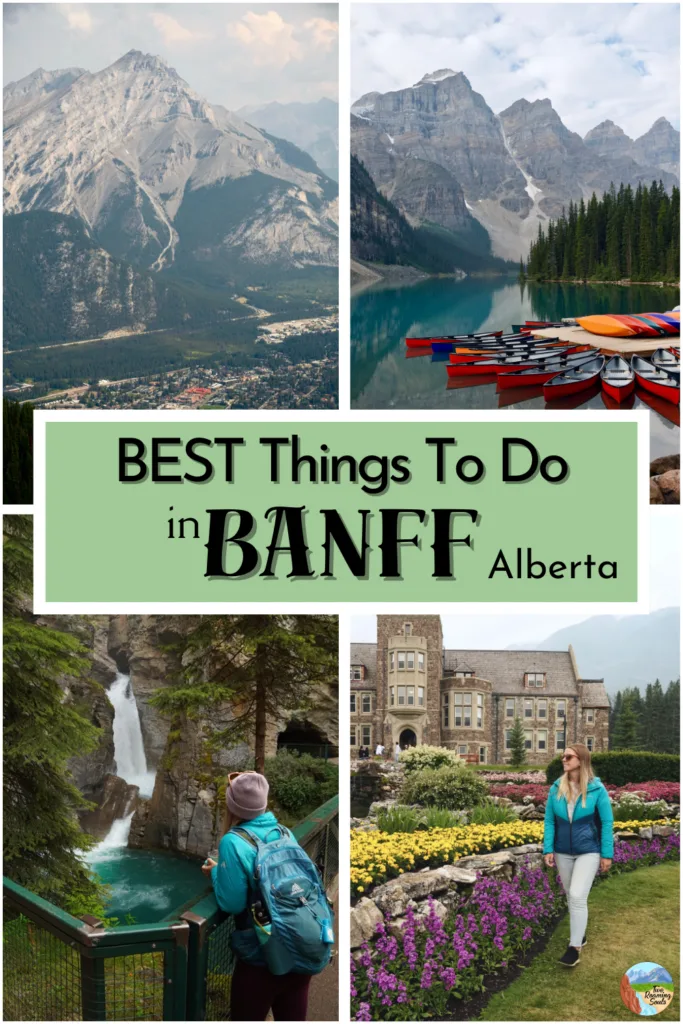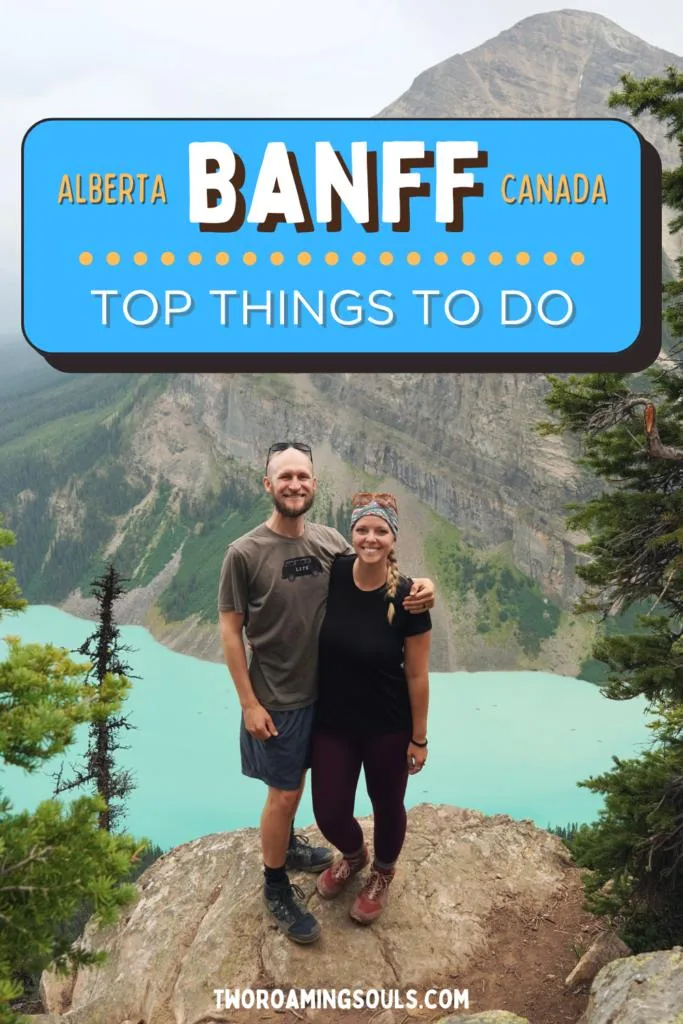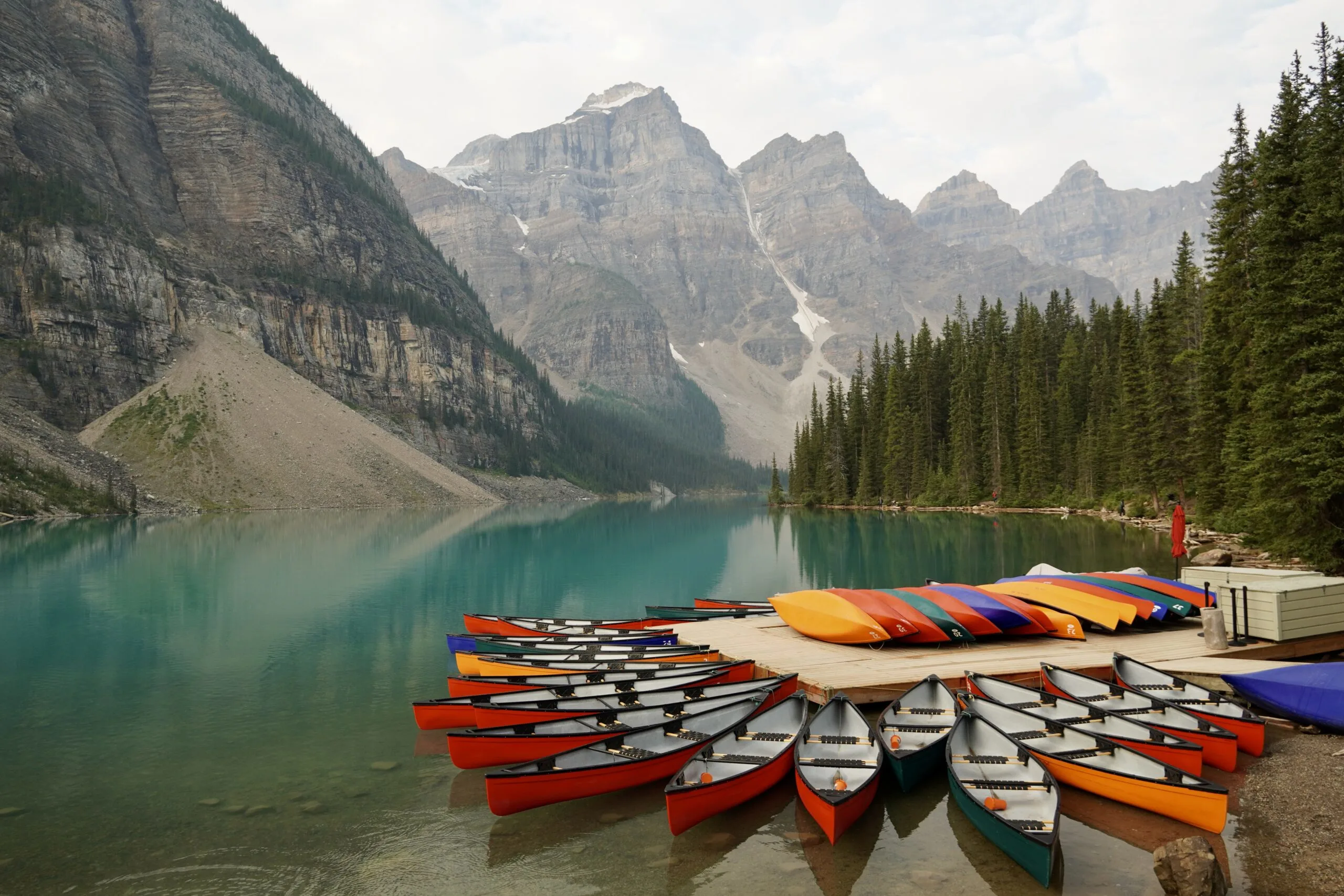
Banff is, without a doubt, one of the most stunning destinations in the world. It’s located in Alberta Canada, among the Rocky Mountains. The town of Banff itself is located in Banff National Park, Canada’s first national park.
This region is home to exceptionally beautiful mountains, lakes, rivers, hot springs, and more. In this guide, we share our favorite things to do here, plus tips for getting the most out of your visit.
Refer to our custom map for help locating our favorite Banff attractions
Moraine Lake
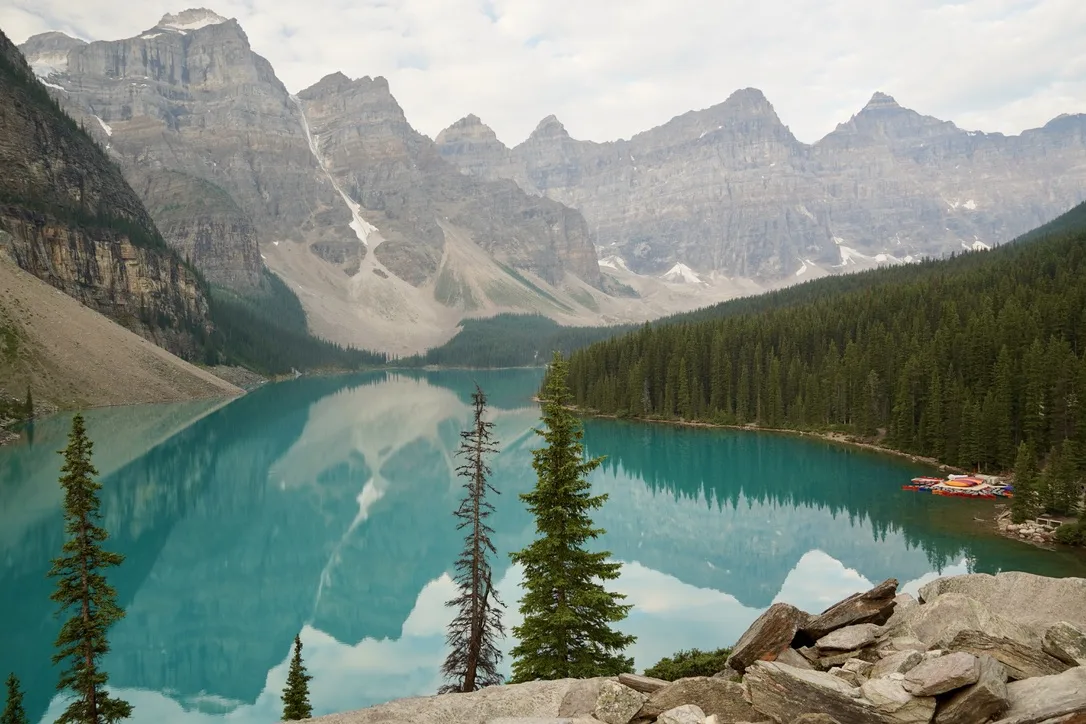
This iconic lake in Banff National Park features incredible turquoise blue water, set against possibly the most picturesque mountain backdrop anywhere in the world. With ten layered peaks just perfectly curving around the west end of the lake.
The most famous photo spot is called the rock pile. The hike to the top of the rockpile is less than a half-kilometer from the shuttle drop-off.
We will cover more about getting here in the next section since getting to both Moraine Lake and Lake Louise can be accessed from the same shuttle services.
Lake Louise
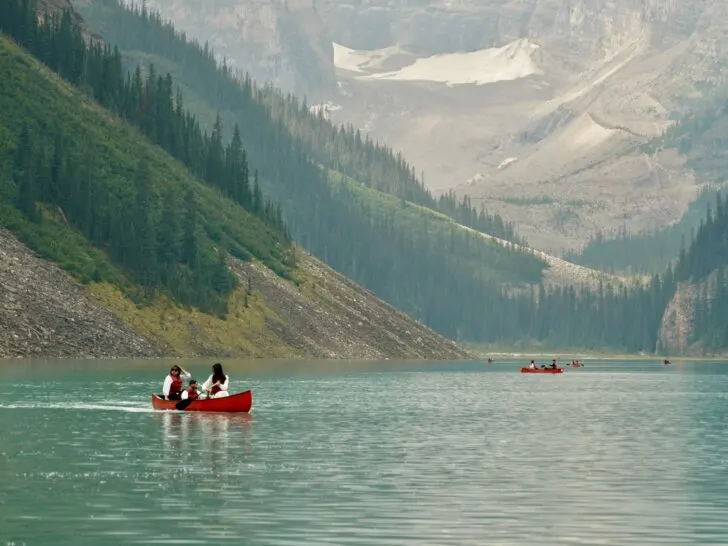
This is another jaw-dropping glacial lake that you can’t miss on your trip to Banff. It has a stunning view of the Victoria Glacier at the west end of the lake.
Lake Louise is the name of the lake, the town, and the ski resort across the highway, so it can get a little confusing.
Lake Louise and Moraine Lake are possibly the most sought-after places to visit in all of Canada. And their proximity to each other makes visiting both of them at the same time very common.
Most visitors come in summer when the lakes are thawed and their stunning colors are on full display. However, you can visit Lake Louise in the Spring, Fall, and Winter as well. (Technically, you can visit Moraine Lake in the winter too, but it requires special skills and knowledge for backcountry winter travel).
But the popularity of these lakes brings challenges for visiting, and of course, crowds. Seriously, the lakeshores in the summer can feel closer to Disney World, than any alpine lake you’ve been to.
Ways To Visit Lake Louise & Moraine Lake
- Shuttle Reservation (May-October)
- Roam Public Transit (Year Round)
- Private tour company (Year-Round)
- By foot or bicycle (May-October)
- Driving a personal vehicle (Year-Round, Lake Louise Only, NOT Recommended)
- Booking lodging at the Moraine Lake Lodge
- Booking lodging at the Fairmont Chateau Lake Louise
Shuttle Services to Lake Louise & Moraine Lake
Technically, you can drive to the paid parking lots at Lake Louise Lakeshore, but in the summer they are full from basically sunrise to sunset. According to the Parks Canada website, “visitors without reservations are unlikely to find parking at Lake Louise”.
Moraine Lake is even harder to access than Lake Louise because, since 2023, no personal vehicles at all are allowed to drive to the Lake. (Except for disability and guests of Moraine Lake Lodge)
And the road to Moraine Lake is typically only open from about June to October, but timing can fluctuate based on snow and avalanche conditions.
Instead, Parks Canada has created a shuttle system in the summer to provide an affordable and easy way to visit Lake Louise and Moraine Lake.
A large percentage of the shuttle reservations for the year are made available in mid-April, with the rest being released on a rolling basis, 2 days before your visit date (at 8 am Mountain Time).
But visit the Parks Canada website for the most up-to-date information.
Riders with a valid shuttle reservation can park for free at the Park & Ride located at Lake Louise Ski Resort. This grants you access to both lakes with travel in between provided by the Lake Connector Shuttle.
Basically, you can stay as long as you like at each lake, and receive a shuttle back to the Park & Ride when you are finished.
The ‘Alpine Start’ shuttles are the best option for getting to Moraine Lake for sunrise. They leave at 4 am and 5 am.
What To Do At Moraine Lake & Lake Louise
Simply admiring these lakes from the shore is a spectacular experience.
Both lakes have canoe rentals, which can be a fun way to see and experience these lakes up close. But prices are notoriously expensive at around $145 per hour!
There are tons of hikes of all lengths and distances to explore around each lake. From leisurely lakeside strolls all the way up to advanced mountaineering, and plenty in between.
And one classic hike is actually the next thing on the list.
Visit A Tea House
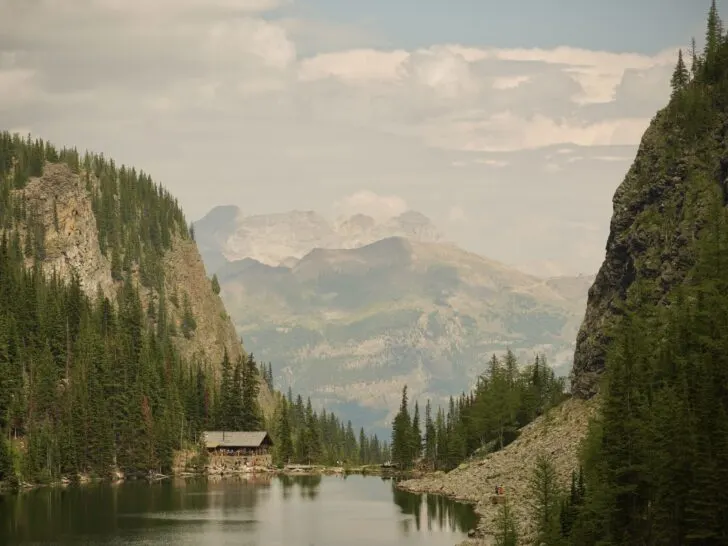
Banff National Park has two backcountry tea houses near Lake Louise, Lake Agnes Tea House and the Plain of 6 Glaciers Tea House. Both offer a unique chance to get food and drinks surrounded by beautiful nature.
They are probably most well known for serving delicious teas and pastries. But they have some other drinks and snacks too. And be aware that they don’t have ice, we were both excited for a refreshing iced tea, so we were a little bummed to find out they only have hot or room temp drinks.
They prefer if you pay cash, and rely on customers to pack out their trash, or even volunteer to take some other trash with you.
Both Tea Houses are typically reached by hikes beginning at the Lake Louise Waterfront.
- The Lake Agnes Tea House is 3.2km *one way (2 miles).
- And the Plain Of 6 Glaciers Tea House is 7km *one way (4.3 miles).
You can reach them as just out-and-back hikes, or several other variations and loops to other popular stops in the area. There is even an 18km route that combines them both into one hike. (11.3 miles).
Big Beehive
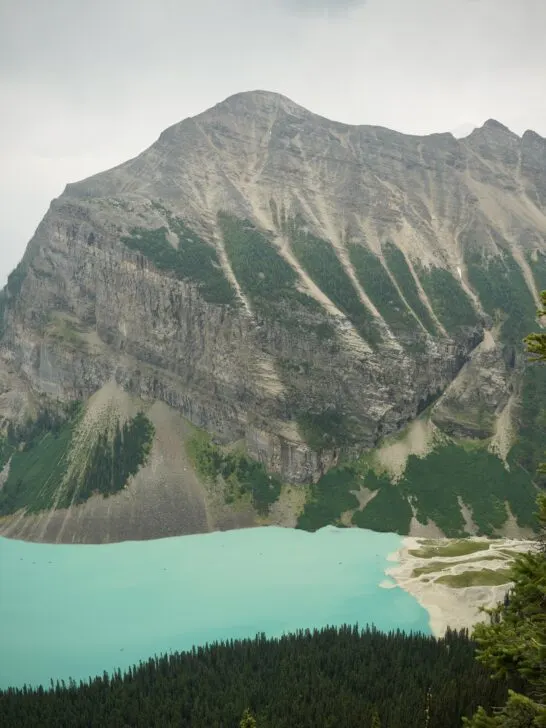
The Big Beehive is a famous viewpoint above Lake Louise. It’s a worthy destination in its own right, but also can be combined with hikes to the tea houses as well.
We were really happy that we found the energy to hike up to the Big Beehive. Because it was one of the most incredible views of our entire time in Banff.
From here, it’s amazing to see the river mixing into Lake Louise. It carries a glacial sediment called rock flour that, once diluted, is responsible for that stunning blue color.
Johnston Canyon
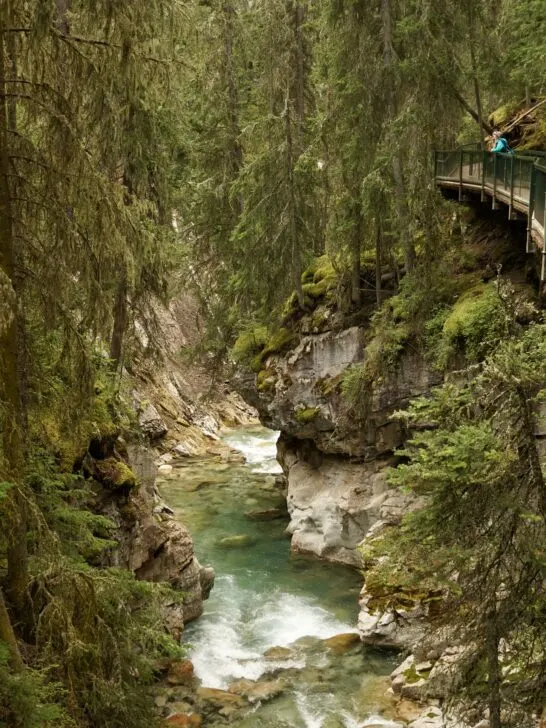
Johnston Canyon is one of the most spectacular attractions in Banff National Park. And it offers scenery that’s a bit different than most other things around Banff.
The highlights of this 5.5km hike are the lower and Upper falls, along with several other smaller waterfalls. But you will probably find tons of moments worthy of stopping to marvel at the beauty. Suspended wooden boardwalks allow visitors of all ability levels to delve into the wonder of this rugged canyon.
And truly there is no single final destination, you can hike in as far as you like.
I must stress that this is one destination where avoiding the crowds is highly recommended.
The narrow out-and-back trail just makes the crowds feel so much more condensed.
So visiting early in the morning or late in the evening is your best chance to avoid crowds. Or you can visit during spring and fall, or even winter when lots of snow and ice transform the landscape into something so unique.
Ride The Banff Gondola
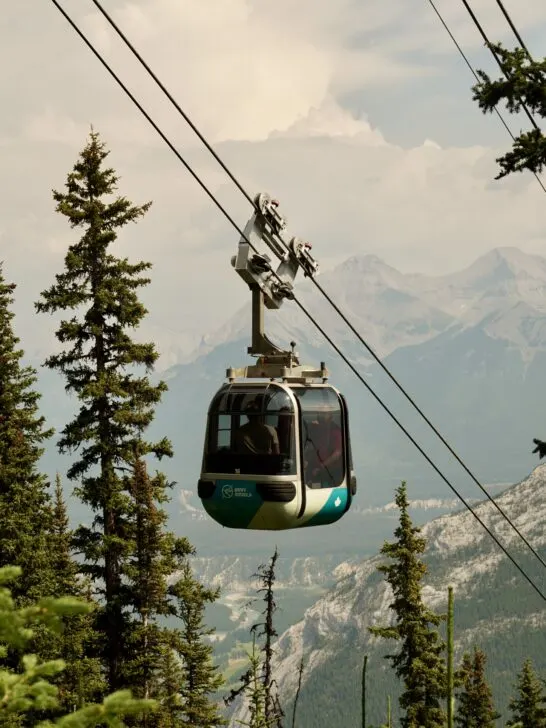
This scenic gondola ride whisks you up to one of the best views of Banff. From here you get stunning views of six different mountain ranges, the town of Banff, the Bow River, Tunnel Mountain, and many other notable landmarks.
Once at the top you can take a short walk to the Cosmic Ray Station. This historic research installment is the site with arguably the best views of Banff.
And back at the top of the Gondola, you can explore the exhibits in the museum, grab a quick bite or drink at the coffee shop, enjoy a beer on the rooftop patio, have a causal sit down meal at the Northern Lights Alpine Kitchen, or really indulge with a fine dining experience at the Sky Bistro. All of which have world-class views.
The gondola is open year-round and pricing varies based on projected demand. But booking at least 48 hours in advance always receives the cheapest rates. Tickets are $66 and up per adult.
Or you can skip the gondola entirely and hike up the Sulphur Mountain Trail for free (summer only). The trail is 10.8km and climbs up 755 meters on pretty relentless switchbacks (6.7 miles, 2,477ft).
You can also potentially hike up and ride the gondola down. (Or vice versa) but a spot on the gondola is not guaranteed and subject to availability. So always prepare to hike the whole thing if necessary.
Explore Downtown Banff
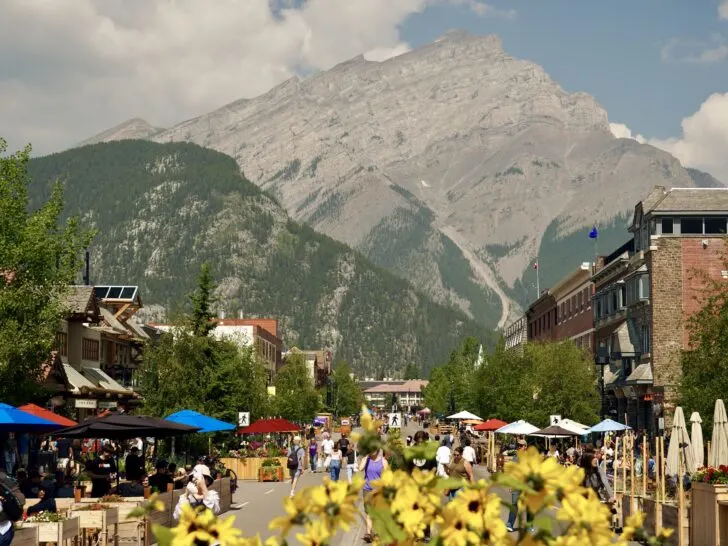
Stop into the shops and restaurants in Downtown Banff.
The main street, called Banff Ave, is closed to motor vehicles between Wolf and Buffalo Street (except buses). This creates an enjoyable experience strolling downtown. (And makes it easier to get those iconic Banff shots with Cascade Mountain as the background.)
There are tons of restaurants, bars, shops, and museums to keep you entertained in Banff.
Personally, we always love to visit the local breweries. So we stopped into Banff Ave Brewing and Three Bears Brewing. Both are worthy stops for some food and drinks.
Banff Ave with their balcony right above the bustle of town. And Three Bears for their nature-inspired decor and retractable roof.
Another legendary Banff restaurant we tried is Magpie & Stump. They serve delicious Mexican food, with an especially affordable happy hour. The upstairs is a vibrant open-air patio, and the downstairs is a cozy wooden tavern vibe.
Drive The Icefields Scenic Parkway
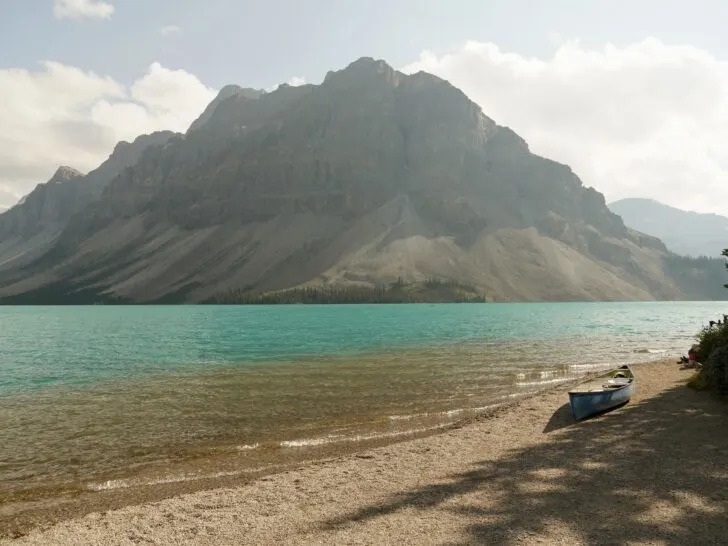
This 227 km mountain road between Lake Louise and Jasper showcases some of the most incredible scenery in Banff National Park (and also Jasper National Park).
There are ancient glaciers, stunning alpine lakes, waterfalls, wildlife, and more. There’s nearly a lifetime of incredible nature to explore along this stretch of highway.
But driving the road and stopping at some popular spots is a great start. It’s honestly unfathomable the beauty that you can see just steps from the parking lots and pullouts.
The real highlights for us were paddle boarding on Bow Lake and watching sunset over Peyto Lake from Bow Summit.
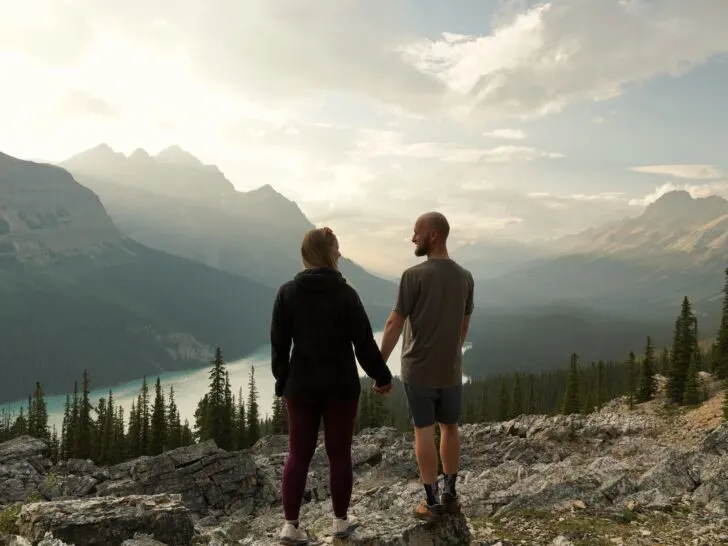
The short hike to the Peyto Lake viewpoint delivered an incredibly beautiful sunset that we will remember forever.
Another absolutely exceptional destination is The Columbia Icefield, which lies at the northern tip of Banff National Park. You can just admire the glaciers from afar, walk the glass bottom skywalk, or ride up close on the famous Ice Explorer.
Other popular stops include Waterfowl Lakes, Athabasca Falls, and Big Bend. But again, this is barely scratching the surface.
Banff Hot Springs
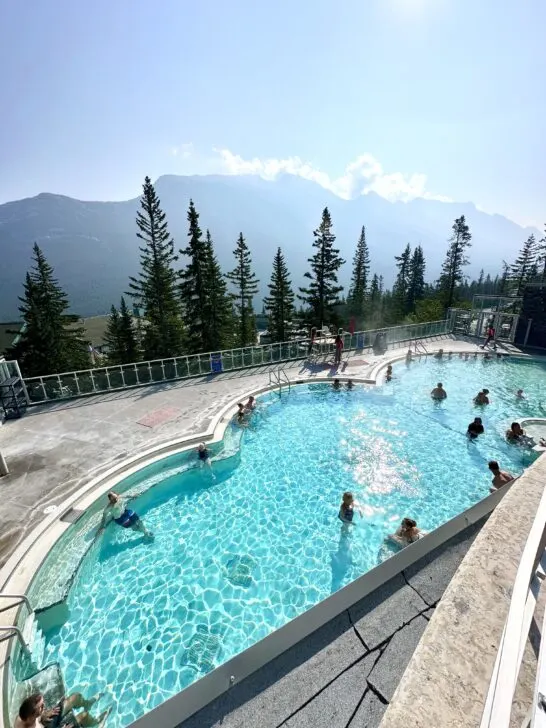
These thermal hot springs at the base of Sulphur Mountain are a classic Banff activity. For generations, people have been enjoying the relaxing and nourishing spring water.
It located right at the base of the Banff gondola, so it’s popular to do these activities at the same time.
It’s a large pool man-made pool, but it still gets crowded during most days.
It’s $17.55 for adults, $15.25 for kids, and free under 3 years old.
They give you a free locker token and also have towels and bathing suits for rent.
There is limited parking, so if you don’t go first thing in the morning or really late in the evening, you should consider taking the free bus up from town.
You can stay as long as you like in the hot springs, enjoying the views of Mount Rundle and Cascade Mountain.
Mount Assiniboine
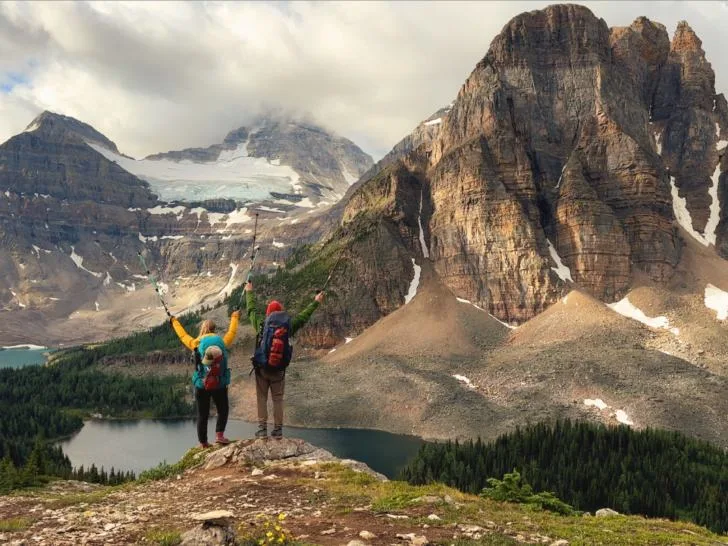
This prominent pyramid peak in the Canadian Rockies stands tall above some of the most stunning backcountry in the area. But getting here is anything but straightforward.
And, it’s not exactly in Banff. And actually, Mount Assiniboine Provincial Park is actually in British Columbia. But one of the routes to get here involved going through Banff.
There are no roads into the park, so the only way to visit this place is by hiking or booking a helicopter transfer.
It makes for an exceptional multi-day backpacking trip, with most trips planned around getting permits for Magog Lake Campground. Which is the ideal basecamp for exploring the trails in the area. Or you can book accommodation in the Mount Assiniboine Lodge or in their cabins and huts.
There is a ton to know about planning this adventure, which is why we made an entire blog post all about visiting Mt Assiniboine.
Lake Minnewanka Scenic Loop
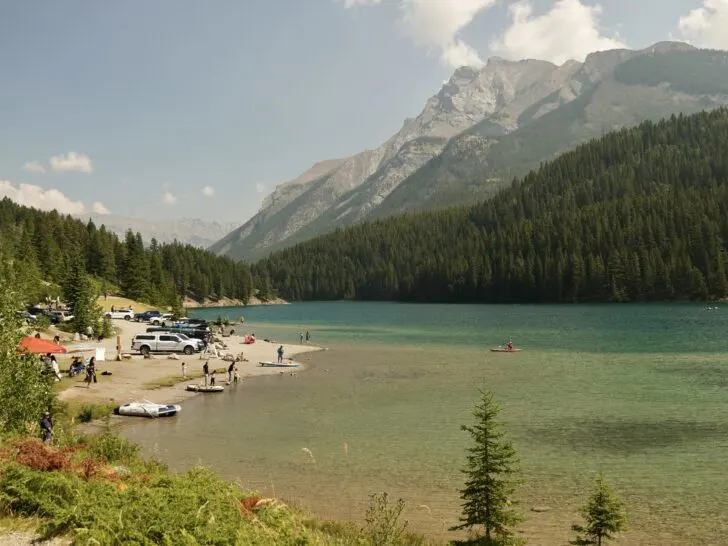
This scenic drive near Banff packs so many incredible lakes into one short trip. It’s a great place to swim, paddle, hike, or simply take in the views of the drive.
Lake Minnewanka is by far the biggest in this area, stretching 21km and flanked by stunning mountains on both sides. So the best way to see it all is by booking the scenic boat cruise.
Or they also have canoe, kayak, and motorboat rentals.
However, on such a big lake, we recommend going in the morning because wind often makes the water pretty rough in the afternoon.
But even if you don’t get out on the lake, on shore there’s a beach, some picnic tables, a restaurant, and a popular short hike to Stewart Canyon.
Other smaller lakes on the scenic loop also make great destinations. There’s Two Jack Lake, Johnson Lake, and Cascade Pond.
Two Jack and Johnson are much smaller than Minniwanka, so they are great for kayaking and paddle boarding.
And Cascade Pond is even smaller still, perhaps a little too small for paddling, but it has great green space, picnic tables, and it’s famous for its picturesque wooden bridges.
Where To Stay In Banff
Banff National Park covers a wide range of acres. Many of the things we mention above stretch from the town of Canmore to the town of Lake Lousie. There are also some accommodation options between the two towns. But the towns will offer a wider array of accommodation styles. Use the map below to find great hotels and vacation rentals surrounding the Banff area.
Additional Tip For Visiting Banff
Here are a few additional tips for visiting Banff.
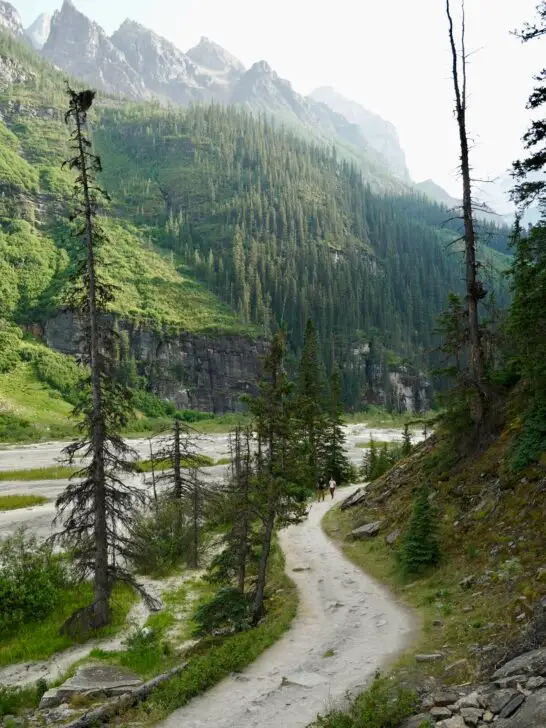
Best Time To Visit Banff
Banff’s high season for tourism is summer. This is when the alpine lakes are thawed and warm daytime temperatures are ideal for hiking, biking, camping, swimming, and more.
Shoulder seasons bring cooler temperatures and also way fewer crowds. And Banff is still a very popular winter destination, with ski resorts becoming yet another huge draw for visitors. But during the winter, prepare for some things on this list to be closed or less accessible due to snow.
National Parks Pass
Before visiting, you should consider what kind of National Parks pass works best for you.
Parks Canada has a variety of different pass options for individuals or families, single day passes just for Banff National Park, all the way up to the Discovery Pass, Canadas annual national parks pass. Day passes for Banff National Park are only available for purchase in person, but the annual passes can be purchased online or in person.
With other amazing national parks nearby, like Yoho, Jasper, and Kootenay it’s not too hard to get your moneys worth from a Discovery Pass.
We traveled to most of these places in our campervan. But for pretty much everything around Banff, there are really good public transit options and so many tour companies. So you can get to almost any of these destinations without a car, and for some things, you may appreciate more of a guided experience.
Pursuit Pass
The Banff Gondola, Columbia Icefields, Lake Minnewanka Cruise are all managed by Pursuit. So if you plan to pay for all of these things, you can save money by booking a Pursuit Pass.
Save This Post For Later!
